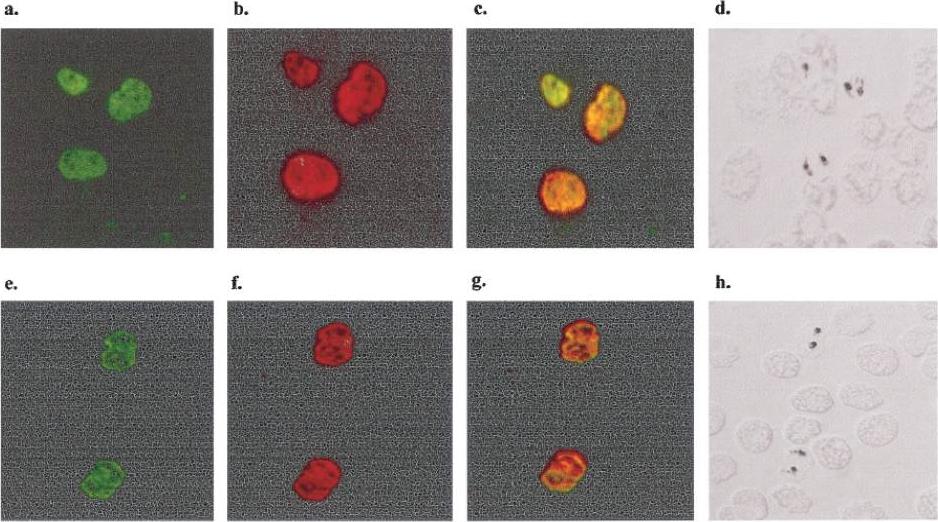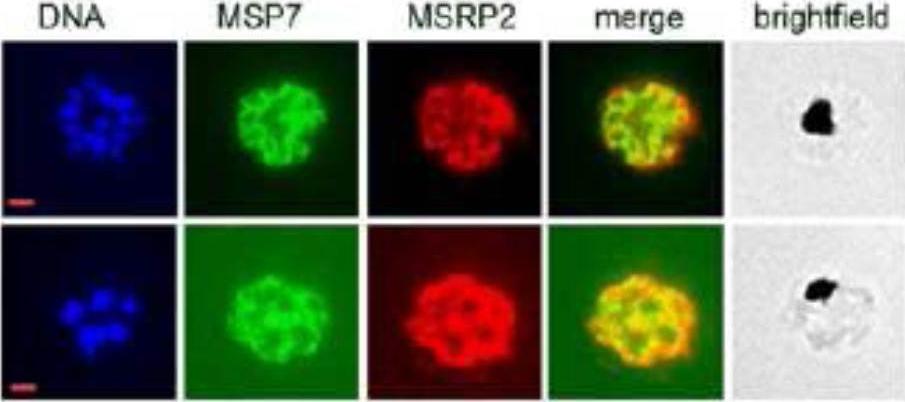PF3D7_1334800 MSP7-like protein (MSRP2)
Disruptability [+]
| Species | Disruptability | Reference | Submitter | |
|---|---|---|---|---|
| P. falciparum 3D7 |
Possible |
20472690 | Theo Sanderson, Wellcome Trust Sanger Institute | |
| P. falciparum 3D7 |
Possible |
USF piggyBac screen (Insert. mut.) | USF PiggyBac Screen | |
| P. berghei ANKA |
Possible |
RMgm-673 | Imported from RMgmDB | |
| P. berghei ANKA |
Possible |
RMgm-671 | Imported from RMgmDB | |
| P. berghei ANKA |
Possible |
RMgm-224 | Imported from RMgmDB | |
Mutant phenotypes [+]
| Species | Stage | Phenotype | Reference | Submitter |
|---|---|---|---|---|
| P. falciparum 3D7 | Asexual |
No difference |
20472690 | Theo Sanderson, Wellcome Trust Sanger Institute |
| P. berghei ANKA | Asexual |
Difference from wild-type |
RMgm-673
msp7 infected BALB/c mice showed only a mild delay in the parasite growth rate during the initial phase of infection. The mice progressively developed a high parasitemia and died during the third week post infection similarly to wild type-infected mice.In C57BL/6 mice, msp7 parasites showed a significant reduction of the growth rate up to day 12 post infection and failed to induce signs and symptoms of ECM. These mice showed a prolonged course of infection with increasing parasitemia and died during the fourth week post infection with a peak parasitemia reaching 70%. All wild type-infected mice died at around day 8 post-infection when the parasitemia was still low (around 20%) developing a typical ECM pathology. The virulence attenuated phenotype of msp7 parasites varied with the mouse strain used. A substantial fraction of infected msp7 CD1 mice (about 60%) died within 10 days post-infection with signs and symptoms of ECM and with a parasitemia below 15% while the others mice died later of severe anemia. |
Imported from RMgmDB |
| P. berghei ANKA | Asexual |
Difference from wild-type |
RMgm-671
Mutant blood stages show a minor growth defect resulting in a lower growth rate in BALB/c mice during the initial phase of infection (day 8/10). At later stages of infection (when reticulocytes are prevalent), the growth rate was similar to that of wild type parasites. In aged WISTAR rats (15 weeks) the mutant blood stages showed a reduced growth and virulence phenotype. |
Imported from RMgmDB |
| P. berghei ANKA | Asexual |
Difference from wild-type |
RMgm-224
Mutants show a minor growth defect resulting in a lower growth rate in Balb/c mice during the initial phase of infection. When reticulocytes were prevalent (after day 9 after infection), the growth rate was similar to that of wild type parasites |
Imported from RMgmDB |
Imaging data (from Malaria Metabolic Pathways)

Colocalization of PfMSRP-1 and PfMSRP-2 with P. falciparum MSP-1 as demonstrated by immunofluorescence of thin blood smears of asynchronous cultures. (a) Slides were incubated with a mouse anti-PfMSRP-1 serum and a fluorescein isothiocyanate-labeled rabbit anti-mouse IgG secondary antibody. (b and f) Slides were incubated with a guinea pig anti-Pf83a serum and a rhodamine-labeled donkey anti-guinea pig IgG secondary antibody. (c) Overlay of panels a and b. (d) Bright-field image of panels a, b, and c. (e) Slides were incubated with a mouse anti-PfMSRP-2 serum and a fluorescein isothiocyanate-labeled rabbit anti-mouse IgG secondary antibody. (g) Overlay of panels e and f. (h) Bright-field image of panels e, f, and g. PfMSRP-1 and PfMSRP-2 were localized to the membranes of trophozoites (a and e). This is similar to the pattern observed with the amino-terminal portion of PfMSP-1 (b and f).Mello K, Daly TM, Morrisey J, Vaidya AB, Long CA, Bergman LW. A multigene family that interacts with the amino terminus of plasmodium MSP-1 identified using the yeast two-hybrid system. Eukaryot Cell. 2002 1(6):915-25.
See original on MMP
Co-localization of MSP7 and MSRP2. Late-stage parasites were formaldehyde-fixed, acetone-permeabilised and reacted with mAb 2G10, (mouse monoclonal anti-MSP7 antibody) and rabbit polyclonal anti-MSRP2 antibodies in an immunofluorescence assay.Kadekoppala M, Ogun SA, Howell S, Gunaratne RS, Holder AA. A systematic genetic analysis of the Plasmodium falciparum MSP7-like family reveals differences in protein expression, location and importance in asexual growth of the blood stage parasite. Eukaryot Cell. 2010 9:1064-74.
See original on MMPMore information
| PlasmoDB | PF3D7_1334800 |
| GeneDB | PF3D7_1334800 |
| Malaria Metabolic Pathways | Localisation images Pathways mapped to |
| Previous ID(s) | MAL13P1.174 |
| Orthologs | PBANKA_1349100 , PCHAS_1353700 , PKNH_1266000 , PVP01_1219700 , PVP01_1220000 , PVP01_1220200 , PVX_082655 , PVX_082665 , PVX_082680 , PY17X_1354100 |
| Google Scholar | Search for all mentions of this gene |